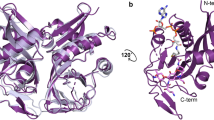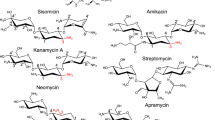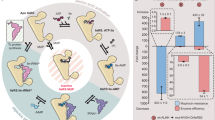Abstract
The efficacy of aminoglycoside antibiotics is waning due to the acquisition of diverse resistance mechanisms by bacteria. Among the most prevalent are aminoglycoside acetyltransferases (AACs) that inactivate the antibiotics through acetyl coenzyme A-mediated modification. Most AACs are members of the GCN5 superfamily of acyltransferases which lack conserved active site residues that participate in catalysis. ApmA is the first reported AAC belonging to the left-handed β-helix superfamily. These enzymes are characterized by an essential active site histidine that acts as an active site base. Here we show that ApmA confers broad-spectrum aminoglycoside resistance with a molecular mechanism that diverges from other detoxifying left-handed β-helix superfamily enzymes and canonical GCN5 AACs. We find that the active site histidine plays different functions depending on the acetyl-accepting aminoglycoside substrate. This flexibility in the mechanism of a single enzyme underscores the plasticity of antibiotic resistance elements to co-opt protein catalysts in the evolution of drug detoxification.

This is a preview of subscription content, access via your institution
Access options
Access Nature and 54 other Nature Portfolio journals
Get Nature+, our best-value online-access subscription
$29.99 / 30 days
cancel any time
Subscribe to this journal
Receive 12 print issues and online access
$259.00 per year
only $21.58 per issue
Buy this article
- Purchase on Springer Link
- Instant access to full article PDF
Prices may be subject to local taxes which are calculated during checkout





Similar content being viewed by others
Data availability
The data that support the findings of this study is available within the main text and its Supplementary Information files; the crystal structures are available under accession codes PDB 7UUJ, 7UUK, 7UUL, 7UUM, 7UUN and 7UUO, with 7JM0 a previously published structure used as a model for molecular replacement. Source data are provided with this paper. Data is also available from the corresponding author upon request.
References
Bottger, E. C. & Crich, D. Aminoglycosides: time for the resurrection of a neglected class of antibacterials? ACS Infect. Dis. 6, 168–172 (2020).
Ban, Y. H., Song, M. C., Park, J. W. & Yoon, Y. J. Minor components of aminoglycosides: recent advances in their biosynthesis and therapeutic potential. Nat. Prod. Rep. 37, 301–311 (2020).
Vicens, Q. & Westhof, E. RNA as a drug target: the case of aminoglycosides. ChemBioChem 4, 1018–1023 (2003).
Serio, A. W., Magalhães, M. L., Blanchard, J. S. & Connolly, L. E. A in Antimicrobial Drug Resistance (eds. Mayers, D. L. et al.) 213–229 (Springer, 2017).
Matt, T. et al. Dissociation of antibacterial activity and aminoglycoside ototoxicity in the 4-monosubstituted 2-deoxystreptamine apramycin. Proc. Natl Acad. Sci. USA 109, 10984–10989 (2012).
Bassenden, A. V., Rodionov, D., Shi, K. & Berghuis, A. M. Structural analysis of the tobramycin and gentamicin clinical resistome reveals limitations for next-generation aminoglycoside design. ACS Chem. Biol. 11, 1339–1346 (2016).
Zárate, S. G. et al. Overcoming aminoglycoside enzymatic resistance: design of novel antibiotics and inhibitors. Molecules 23, 284 (2018).
Pfister, P., Hobbie, S., Vicens, Q., Bottger, E. C. & Westhof, E. The molecular basis for A-site mutations conferring aminoglycoside resistance: relationship between ribosomal susceptibility and X-ray crystal structures. ChemBioChem 4, 1078–1088 (2003).
Cox, G. et al. Plazomicin retains antibiotic activity against most aminoglycoside modifying enzymes. ACS Infect. Dis. 4, 980–987 (2018).
Doi, Y., Wachino, J. I. & Arakawa, Y. Aminoglycoside resistance: the emergence of acquired 16S ribosomal RNA methyltransferases. Infect. Dis. Clin. North Am. 30, 523–537 (2016).
Juhas, M. et al. In vitro activity of apramycin against multidrug-, carbapenem- and aminoglycoside-resistant Enterobacteriaceae and Acinetobacter baumannii. J. Antimicrob. Chemother. 74, 944–952 (2019).
Hu, Y., Liu, L., Zhang, X., Feng, Y. & Zong, Z. In vitro activity of neomycin, streptomycin, paromomycin and apramycin against carbapenem-resistant Enterobacteriaceae clinical strains. Front. Microbiol. 8, 2275 (2017).
Ishikawa, M. et al. Lower ototoxicity and absence of hidden hearing loss point to gentamicin C1a and apramycin as promising antibiotics for clinical use. Sci. Rep. 9, 2410 (2019).
Matsushita, T. et al. Design, multigram synthesis, and in vitro and in vivo evaluation of propylamycin: a semisynthetic 4,5-deoxystreptamine class aminoglycoside for the treatment of drug-resistant Enterobacteriaceae and other Gram-negative pathogens. J. Am. Chem. Soc. 141, 5051–5061 (2019).
Sati, G. C. et al. Modification at the 2′-position of the 4,5-series of 2-deoxystreptamine aminoglycoside antibiotics to resist aminoglycoside modifying enzymes and increase ribosomal target selectivity. ACS Infect. Dis. 5, 1718–1730 (2019).
Plattner, M., Gysin, M., Haldimann, K., Becker, K. & Hobbie, S. N. Epidemiologic, phenotypic, and structural characterization of aminoglycoside-resistance gene aac(3)-IV. Int. J. Mol. Sci. 21, 6133 (2020).
Magalhaes, M. L. & Blanchard, J. S. The kinetic mechanism of AAC(3)-IV aminoglycoside acetyltransferase from Escherichia coli. Biochemistry 44, 16275–16283 (2005).
Fessler, A. T., Kadlec, K. & Schwarz, S. Novel apramycin resistance gene apmA in bovine and porcine methicillin-resistant Staphylococcus aureus ST398 isolates. Antimicrob. Agents Chemother. 55, 373–375 (2011).
Bordeleau, E. et al. ApmA is a unique aminoglycoside antibiotic acetyltransferase that inactivates apramycin. mBio 12, e02705-20 (2021).
Quirke, J. C. K. et al. Apralogs: apramycin 5-O-glycosides and ethers with improved antibacterial activity and ribosomal selectivity and reduced susceptibility to the aminoacyltranserferase (3)-IV resistance determinant. J. Am. Chem. Soc. 142, 530–544 (2020).
Draker, K. A. & Wright, G. D. Molecular mechanism of the enterococcal aminoglycoside 6′-N-acetyltransferase: role of GNAT-conserved residues in the chemistry of antibiotic inactivation. Biochemistry 43, 446–454 (2004).
Stogios, P. J. et al. Potential for reduction of streptogramin A resistance revealed by structural analysis of acetyltransferase VatA. Antimicrob. Agents Chemother. 58, 7083–7092 (2014).
Beaman, T. W., Sugantino, M. & Roderick, S. L. Structure of the hexapeptide xenobiotic acetyltransferase from Pseudomonas aeruginosa. Biochemistry 37, 6689–6696 (1998).
Murray, I. A. & Shaw, W. V. O-Acetyltransferases for chloramphenicol and other natural products. Antimicrob. Agents Chemother. 41, 1–6 (1997).
Botto, R. E. & Coxon, B. Two-dimensional proton J-resolved NMR spectroscopy of neomycin B. J. Carbohydr. Chem. 3, 545–563 (1984).
Hanessian, S., Takamoto, T., Massé, R. & Patil, G. Aminoglycoside antibiotics: chemical conversion of neomycin B, paromomycin, and lividomycin B into bioactive pseudosaccharides. Can. J. Chem. 56, 1482–1491 (1978).
Eneva, G. I., Spassov, S. L., Haimova, M. A. & Sandström, J. Complete 1H and 13C NMR assignments for apramycin, sisomicin and some N‐ and N, O‐polyacetylated aminoglycosides. Magn. Reson. Chem. 30, 841–846 (1992).
Koshland, D. E. Protein shape and biological control. Sci. Am. 229, 52–67 (1973).
Radika, K. & Northrop, D. B. Correlation of antibiotic resistance with Vmax/Km ratio of enzymatic modification of aminoglycosides by kanamycin acetyltransferase. Antimicrob. Agents Chemother. 25, 479–482 (1984).
Ellis, J., Bagshaw, C. R. & Shaw, W. V. Substrate binding to chloramphenicol acetyltransferase: evidence for negative cooperativity from equilibrium and kinetic constants for binary and ternary complexes. Biochemistry 30, 10806–10813 (1991).
Yoshii, A., Moriyama, H. & Fukuhara, T. The novel kasugamycin 2′-N-acetyltransferase gene aac(2′)-IIa, carried by the IncP island, confers kasugamycin resistance to rice-pathogenic bacteria. Appl. Environ. Microbiol. 78, 5555–5564 (2012).
Draker, K. A., Northrop, D. B. & Wright, G. D. Kinetic mechanism of the GC N5-related chromosomal aminoglycoside acetyltransferase AAC(6′)-Ii from Enterococcus faecium: evidence of dimer subunit cooperativity. Biochemistry 42, 6565–6574 (2003).
Boehr, D. D., Jenkins, S. I. & Wright, G. D. The molecular basis of the expansive substrate specificity of the antibiotic resistance enzyme aminoglycoside acetyltransferase-6′-aminoglycoside phosphotransferase-2′. The role of Asp-99 as an active site base important for acetyl transfer. J. Biol. Chem. 278, 12873–12880 (2003).
Han, Q. et al. Molecular recognition by glycoside pseudo base pairs and triples in an apramycin–RNA complex. Angew. Chem. Int. Ed. Engl. 44, 2694–2700 (2005).
Golkar, T. et al. Structural basis for plazomicin antibiotic action and resistance. Commun. Biol. 4, 729 (2021).
Walter, F., Vicens, Q. & Westhof, E. Aminoglycoside–RNA interactions. Curr. Opin. Chem. Biol. 3, 694–704 (1999).
Lynch, S. R. & Puglisi, J. D. Structural origins of aminoglycoside specificity for prokaryotic ribosomes. J. Mol. Biol. 306, 1037–1058 (2001).
Vetting, M. W., Hegde, S. S., Javid-Majd, F., Blanchard, J. S. & Roderick, S. L. Aminoglycoside 2′-N-acetyltransferase from Mycobacterium tuberculosis in complex with coenzyme A and aminoglycoside substrates. Nat. Struct. Biol. 9, 653–658 (2002).
Bassenden, A. V. et al. Structural and phylogenetic analyses of resistance to next-generation aminoglycosides conferred by AAC(2′) enzymes. Sci. Rep. 11, 11614 (2021).
Jeong, C. S. et al. Structural and biochemical analyses of an aminoglycoside 2′-N-acetyltransferase from Mycolicibacterium smegmatis. Sci. Rep. 10, 21503 (2020).
Xu, Z. et al. Structural and functional survey of environmental aminoglycoside acetyltransferases reveals functionality of resistance enzymes. ACS Infect. Dis. 3, 653–665 (2017).
Stogios, P. J. et al. Structural and biochemical characterization of Acinetobacter spp. aminoglycoside acetyltransferases highlights functional and evolutionary variation among antibiotic resistance enzymes. ACS Infect. Dis. 3, 132–143 (2017).
Wright, G. D. & Ladak, P. Overexpression and characterization of the chromosomal aminoglycoside 6′-N-acetyltransferase from Enterococcus faecium. Antimicrob. Agents Chemother. 41, 956–960 (1997).
Lewendon, A., Murray, I. A., Shaw, W. V., Gibbs, M. R. & Leslie, A. G. Replacement of catalytic histidine-195 of chloramphenicol acetyltransferase: evidence for a general base role for glutamate. Biochemistry 33, 1944–1950 (1994).
Hindson, V. J. & Shaw, W. V. Random-order ternary complex reaction mechanism of serine acetyltransferase from Escherichia coli. Biochemistry 42, 3113–3119 (2003).
Hindson, V. J., Dunn, S. O., Rowe, A. J. & Shaw, W. V. Kinetic and hydrodynamic studies of the NodL O-acetyl transferase of Rhizobium leguminosarum: a random-order ternary complex mechanism for acetyl transfer by a roughly spherical trimeric protein. Biochim. Biophys. Acta 1479, 203–213 (2000).
Thoden, J. B. et al. Catalytic mechanism of perosamine N-acetyltransferase revealed by high-resolution X-ray crystallographic studies and kinetic analyses. Biochemistry 51, 3433–3444 (2012).
Thoden, J. B., Cook, P. D., Schäffer, C., Messner, P. & Holden, H. M. Structural and functional studies of QdtC: an N-acetyltransferase required for the biosynthesis of dTDP-3-acetamido-3, 6-dideoxy-α-d-glucose. Biochemistry. 48, 2699–2709 (2009).
Olivier, N. B., Chen, M. M., Behr, J. R. & Imperial, B. In vitro biosynthesis of UDP-N,N′-diacetylbacillosamine by enzymes of the Campylobacter jejuni general protein glycosylation system. Biochemistry 45, 13659–13669 (2006).
Rangarajan, E. S. et al. Structure and active site residues of PglD, an N-acetyltransferase from the bacillosamine synthetic pathway required for N-glycan synthesis in Campylobacter jejuni. Biochemistry 47, 1827–1836 (2008).
Acknowledgements
This work used the Centre for Microbial Chemical Biology core facility at McMaster University for antibiotic susceptibility testing. We thank J. Osipiuk and K. Michalska at the Structural Biology Center, Advanced Photon Source, Argonne National Laboratory, for x-ray diffraction data collection. Crystal structures solved in this work were funded in whole or in part with US federal funds from the National Institute of Allergy and Infectious Diseases, National Institutes of Health, Department of Health and Human Services, under contract no. 75N93022C00035-Center for Structural Biology of Infectious Diseases (CSBID). This research was funded by a Canadian Institutes of Health Research grant (no. FRN-148463), the Ontario Research Fund, and a Canada Research Chair to G.D.W.
Author information
Authors and Affiliations
Contributions
E.B. and G.D.W. conceived the study and designed the experiments. E.B. completed all antimicrobial susceptibility testing and wrote the manuscript. Purification of ApmA and acetylated aminoglycosides was completed by E.B. K.K. completed spectroscopic characterization of acetylated aminoglycosides. P.J.S. solved all crystal structures and wrote the manuscript. E.B. completed structural analysis, protein engineering and steady-state kinetics. E.E. performed protein purification and crystallization. A.S. and G.D.W. oversaw the work and wrote the manuscript.
Corresponding author
Ethics declarations
Competing interests
The authors declare no competing interests.
Peer review
Peer review information
Nature Chemical Biology thanks Mickael Blaise, Hyun Ho Park, Marcelo Tolmasky and the other, anonymous, reviewer(s) for their contribution to the peer review of this work.
Additional information
Publisher’s note Springer Nature remains neutral with regard to jurisdictional claims in published maps and institutional affiliations.
Extended data
Extended Data Fig. 1 Chemical structures of AGs referenced in our study and used for antimicrobial susceptibility testing.
AGs are grouped according to structural subclass with carbons colored to distinguish substitution pattern of 2-DOS ring when present. (a) atypical subclass. (b) 4,6-disubstituted AGs. Kanamycin A and B differ at the 2’ position highlighted in red. Amikacin and plazomicin differ at the N6’ position (red highlight), but both contain the same substituent at N1. (c) 4,5-disubstituted AGs.
Extended Data Fig. 2 Electron density of ligands in six crystal structures of ApmA in this study.
Density shown for aminoglycosides in all panels are simulated annealing omit maps, contoured at 2.5 σ. ApmA wildtype in complex with gentamicin (a), tobramycin (b), kanamycin B (c), paromomycin (d), neomycin (e), ApmA(His135Ala) in complex with tobramycin (f). Simulated annealing omit maps are also shown for CoA contoured at 1.5 σ (in grey). Panel (f) also shows a Polder map for CoA contoured at 3.0 σ (in orange/red) and 2Fo-Fc density for the key active site water molecule contoured at 0.8 σ (cyan).
Extended Data Fig. 3 Additional ligand-bound crystal structure complexes.
(a) Amino acids implicated in positioning kanamycin B. All of the observed AG ligands, (b) tobramycin and (c) kanamycin B, bound to ApmA are superimposed. Each ring is identified with a roman numeral and site of acetylation is labelled. (d) Amino acids implicated in positioning gentamicin C1a. (e) Each gentamicin bound to ApmA is superimposed for analysis of sugar ring conformations within each binding pocket. Panel e also highlights torsional angle differences for glycosidic linkages ΦII/III and ψII/III.
Extended Data Fig. 4 Chemical line representation of Asp144Asn substitution impact on AG binding to ApmA.
Rotamer conformations for functional group of Asp144Asn side chain.
Extended Data Fig. 5 Insert loop region of AG binding pocket is most tolerable of mutation when apramycin is the substrate.
Specific activities for (a) ApmA-mediated acetylation and (b) ApmA(His135Ala)-mediated acetylation of AGs were determined in vitro with 1 M AG substrate, 100 µM acetyl-CoA. Individual data points are shown for two independent replicates. Legend: APR – apramycin, pink circles. TOB – tobramycin, purple diamonds. KAN A – kanamycin A, red hexagons. KAN B – kanamycin B, blue triangles. PAR – paromomycin, yellow squares. Individual data points are shown for two independent replicates. (c) Chemical line drawing representation of apramycin acetylation mediated by His135Ala mutant. (d) Chemical line drawing illustration of tobramycin acetylation mediated by His135Ala mutant.
Supplementary information
Supplementary Information
Supplementary Figs. 1–13 and Tables 1–5.
Source data
Source Data Figs. 2 and 5 and Extended Data Fig. 5.
Source kinetics data for Fig. 2b (tab 1) and 2c (tab 2); Fig. 5a and b (tab 3), Fig. 5c and d (tab 4), Extended Data Fig. 5a (tab 5) and Extended Data Fig. 5b (tab 6).
Rights and permissions
Springer Nature or its licensor (e.g. a society or other partner) holds exclusive rights to this article under a publishing agreement with the author(s) or other rightsholder(s); author self-archiving of the accepted manuscript version of this article is solely governed by the terms of such publishing agreement and applicable law.
About this article
Cite this article
Bordeleau, E., Stogios, P.J., Evdokimova, E. et al. Mechanistic plasticity in ApmA enables aminoglycoside promiscuity for resistance. Nat Chem Biol 20, 234–242 (2024). https://doi.org/10.1038/s41589-023-01483-3
Received:
Accepted:
Published:
Issue Date:
DOI: https://doi.org/10.1038/s41589-023-01483-3



